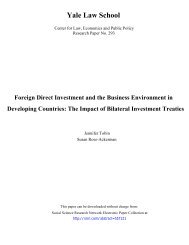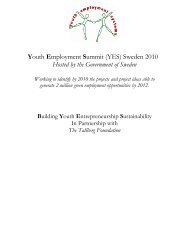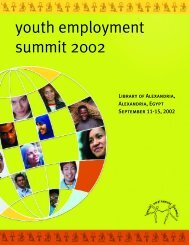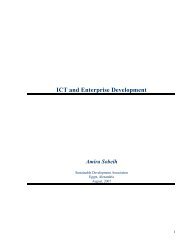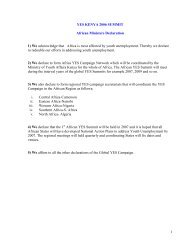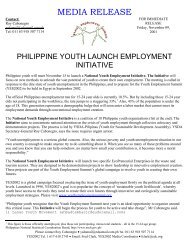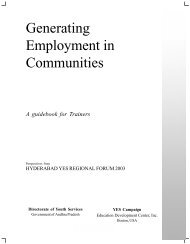EDC's Work in Southeast Asia - Youth Entrepreneurship and ...
EDC's Work in Southeast Asia - Youth Entrepreneurship and ...
EDC's Work in Southeast Asia - Youth Entrepreneurship and ...
Create successful ePaper yourself
Turn your PDF publications into a flip-book with our unique Google optimized e-Paper software.
Nutrition Project <strong>in</strong> Ch<strong>in</strong>a Produces Key Resultsma<strong>in</strong>.edc.org/newsroom/features/ch<strong>in</strong>a.aspA six-school nutrition pilot project <strong>in</strong> Ch<strong>in</strong>a offered to more than 8,000 school staff, students<strong>and</strong> their families has produced significant improvements <strong>in</strong> their knowledge, attitudes, <strong>and</strong>behaviors, promot<strong>in</strong>g optimism that the approach could benefit schools throughout Ch<strong>in</strong>a<strong>and</strong> around the world. Carmen Ald<strong>in</strong>ger of <strong>EDC's</strong> Health <strong>and</strong> Human Development (HHD)Programs recently returned from a f<strong>in</strong>al evaluation visit to the schools, where she <strong>and</strong> <strong>EDC's</strong>partners, the World Health Organization (WHO) <strong>and</strong> the Food <strong>and</strong> Agriculture Organizationof the United Nations (FAO), analyzed evaluation surveys <strong>and</strong> observed the school programs<strong>in</strong> action. The schools are located <strong>in</strong> the cities of Hangzhou <strong>and</strong> Wenzhou <strong>in</strong> the ZhejiangProv<strong>in</strong>ce <strong>in</strong> the southeastern region of Ch<strong>in</strong>a.The two-year program featured tra<strong>in</strong><strong>in</strong>g,plann<strong>in</strong>g, <strong>and</strong> team-build<strong>in</strong>g activities to helpthe schools build nutrition education <strong>and</strong>services. WHO funded the project as part ofits Health-Promot<strong>in</strong>g Schools (HPS)<strong>in</strong>itiative, which encourages schools topromote the healthy development ofstudents, school personnel, families <strong>and</strong>surround<strong>in</strong>g communities with all means attheir disposal. Health <strong>and</strong> learn<strong>in</strong>g are<strong>in</strong>separable, as many studies havedemonstrated, said Ald<strong>in</strong>ger. For the Ch<strong>in</strong>aproject, nutrition education was amean<strong>in</strong>gful “entry po<strong>in</strong>t” <strong>in</strong>to the broadergoal of build<strong>in</strong>g a health-promot<strong>in</strong>g school.HHD conducted this project <strong>in</strong> its role as aWHO Collaborat<strong>in</strong>g Center to Promote Healththrough Schools <strong>and</strong> Communities.“Improvements were found <strong>in</strong> several key areas,” said Ald<strong>in</strong>ger. “By the end of the project,more children were eat<strong>in</strong>g breakfast, enjoy<strong>in</strong>g the school lunches, <strong>and</strong> practic<strong>in</strong>g betterhygienic habits—dr<strong>in</strong>k<strong>in</strong>g clean water <strong>and</strong> not eat<strong>in</strong>g expired foods.” Parents, for example,showed a dramatic <strong>in</strong>crease <strong>in</strong> health knowledge. Their scores on a health survey rose from45% before the program to 73% <strong>in</strong> the f<strong>in</strong>al survey. Significant improvement was also seen<strong>in</strong> student attitudes about such topics as the importance of nutrition <strong>and</strong> HIV education.Behavior improvements, such as the numbers of students wash<strong>in</strong>g h<strong>and</strong>s before eat<strong>in</strong>g,were marked, she said. Among staff at the outset of the program, 24% of staff paidattention to nutrition when plann<strong>in</strong>g meals; by the f<strong>in</strong>al survey 38% did so.“The program drew on the schools' strengths to encourage creative nutrition <strong>in</strong>struction,special projects, parent <strong>in</strong>volvement, <strong>and</strong> overall improvements to the school,” she added.Yu Sen-Hai, WHO consultant, noted, “The pilot schools showed high enthusiasm <strong>and</strong>commitment to nutrition education.” He noted that they all made such impressiveimprovements that they earned WHO's “bronze medal” of HPS achievement.The program <strong>in</strong>volved six schools <strong>and</strong> six others were chosen as controls. In the <strong>in</strong>itialtra<strong>in</strong><strong>in</strong>g <strong>in</strong> April 2000, Ald<strong>in</strong>ger drew on the publication, Healthy Nutrition: An EssentialElement of a Health-Promot<strong>in</strong>g School <strong>in</strong> the WHO Information Series on School Health,jo<strong>in</strong>tly produced by EDC, FAO, <strong>and</strong> WHO. Ald<strong>in</strong>ger, the ma<strong>in</strong> author, together withcolleagues from WHO <strong>and</strong> FAO, offered assistance <strong>in</strong> plann<strong>in</strong>g <strong>and</strong> team development.11




